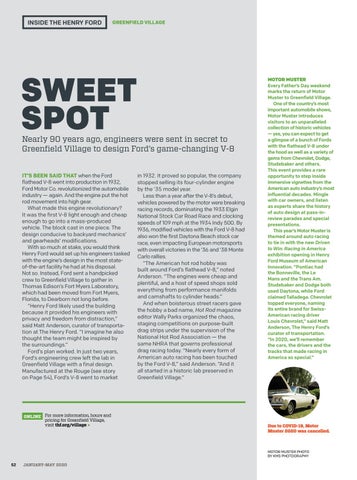INSIDE THE HENRY FORD
GREENFIELD VILLAGE
SWEET SPOT
Nearly 90 years ago, engineers were sent in secret to Greenfield Village to design Ford’s game-changing V-8 IT’S BEEN SAID THAT when the Ford flathead V-8 went into production in 1932, Ford Motor Co. revolutionized the automobile industry — again. And the engine put the hot rod movement into high gear. What made this engine revolutionary? It was the first V-8 light enough and cheap enough to go into a mass-produced vehicle. The block cast in one piece. The design conducive to backyard mechanics’ and gearheads’ modifications. With so much at stake, you would think Henry Ford would set up his engineers tasked with the engine’s design in the most stateof-the-art facility he had at his disposal. Not so. Instead, Ford sent a handpicked crew to Greenfield Village to gather in Thomas Edison’s Fort Myers Laboratory, which had been moved from Fort Myers, Florida, to Dearborn not long before. “Henry Ford likely used the building because it provided his engineers with privacy and freedom from distraction,” said Matt Anderson, curator of transportation at The Henry Ford. “I imagine he also thought the team might be inspired by the surroundings.” Ford’s plan worked. In just two years, Ford’s engineering crew left the lab in Greenfield Village with a final design. Manufactured at the Rouge (see story on Page 54), Ford’s V-8 went to market
ONLINE For more information, hours and pricing for Greenfield Village, visit thf.org/villagec
in 1932. It proved so popular, the company stopped selling its four-cylinder engine by the ‘35 model year. Less than a year after the V-8’s debut, vehicles powered by the motor were breaking racing records, dominating the 1933 Elgin National Stock Car Road Race and clocking speeds of 109 mph at the 1934 Indy 500. By 1936, modified vehicles with the Ford V-8 had also won the first Daytona Beach stock car race, even impacting European motorsports with overall victories in the ‘36 and ‘38 Monte Carlo rallies. “The American hot rod hobby was built around Ford’s flathead V-8,” noted Anderson. “The engines were cheap and plentiful, and a host of speed shops sold everything from performance manifolds and camshafts to cylinder heads.” And when boisterous street racers gave the hobby a bad name, Hot Rod magazine editor Wally Parks organized the chaos, staging competitions on purpose-built drag strips under the supervision of the National Hot Rod Association — the same NHRA that governs professional drag racing today. “Nearly every form of American auto racing has been touched by the Ford V-8,” said Anderson. “And it all started in a historic lab preserved in Greenfield Village.”
MOTOR MUSTER Every Father’s Day weekend marks the return of Motor Muster to Greenfield Village. One of the country’s most important automobile shows, Motor Muster introduces visitors to an unparalleled collection of historic vehicles — yes, you can expect to get a glimpse of a bunch of Fords with the flathead V-8 under the hood as well as a variety of gems from Chevrolet, Dodge, Studebaker and others. This event provides a rare opportunity to step inside immersive vignettes from the American auto industry’s most influential decades. Mingle with car owners, and listen as experts share the history of auto design at pass-inreview parades and special presentations. This year’s Motor Muster is themed around auto racing to tie in with the new Driven to Win: Racing in America exhibition opening in Henry Ford Museum of American Innovation. “Pontiac had the Bonneville, the Le Mans and the Trans Am. Studebaker and Dodge both used Daytona, while Ford claimed Talladega. Chevrolet topped everyone, naming its entire brand for SwissAmerican racing driver Louis Chevrolet,” said Matt Anderson, The Henry Ford’s curator of transportation. “In 2020, we’ll remember the cars, the drivers and the tracks that made racing in America so special.”
Due to COVID-19, Motor Muster 2020 was cancelled.
MOTOR MUSTER PHOTO BY KMS PHOTOGRAPHY
52
JANUARY-MAY 2020
